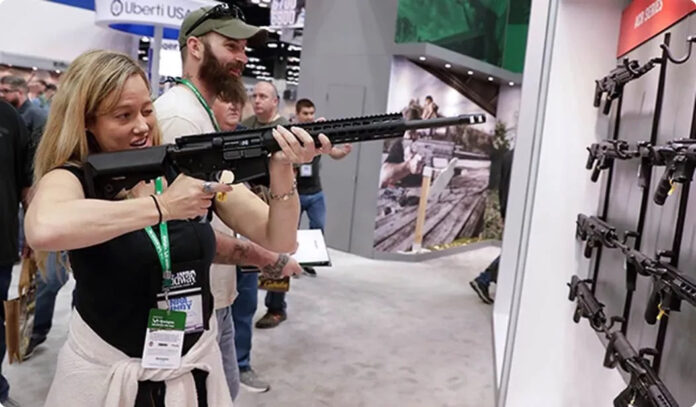After the Fourth Circuit Court of Appeals decided to take a challenge to Maryland’s ban on “assault weapons” en banc before a three-judge panel had the opportunity to release its own opinion on the constitutionality of the ban, it was almost a foregone conclusion that the Fourth Circuit would uphold the law in question. Why else would the appellate court take the almost unprecedented step of taking the case en banc before the three-judge panel that had heard oral arguments had a chance to weigh in?
On Tuesday the en banc decision in Bianchi v. Brown was released, and as expected, the Fourth Circuit declared that Maryland’s gun ban is perfectly compatible with the Constitution, because none of the dozens of firearms banned by name, and the hundreds of models banned by feature, are protected by the language of the Second Amendment.
We hold that the covered firearms are not within the scope of the constitutional right to keep and bear arms for self-defense, and thus Maryland’s regulation of them can peaceably coexist with the Second Amendment. Moreover, even if the text of the Second Amendment were read to encompass the covered firearms, the statutory provisions at issue would nonetheless be constitutional. Our nation has a strong tradition of regulating excessively dangerous weapons once it becomes clear that they are exacting an inordinate toll on public safety and societal wellbeing.
In its decision, the Fourth Circuit judges draped themselves in the mantle of statesmanship, declaring they “choose to honor the worthy virtues of federalism and democracy, not to stifle them.” But the Supreme Court has already said way back in McDonald that the Second Amendment applies to both the states and the federal government thanks to its incorporation under the Fourteenth Amendment, which means that states have no more right to violate the right to keep and bear arms than Congress or the executive branch of the federal government.
The Fourth Circuit held that AR-15s and other semi-automatic long guns are “like” machine guns because they share many cosmetic features with the select-fire rifles used by the military. The semi-automatic nature of the guns sold on the civilian market doesn’t matter much to the judges. They noted that soldiers can use their weapons to fire a single shot with one pull of the the trigger, just like AR-15s, and that, essentially, makes AR-15s and other banned firearms close enough to their military counterparts to fall outside the scope of the Second Amendment’s protections.
By that logic, of course, bans on breech-loading or lever-action rifles would have presumably been constitutional in the 1800s, along with bans on commonly-owned handguns like the Colt Navy and Army revolvers. The historical record is devoid of widespread bans on any of those firearms, but the Fourth Circuit has an answer for that as well.
First, the court misreads Bruen to suggest that a firearm must be “in common use today for self-defense” to be protected by the Second Amendment. That is not what the Court has held, however. While individual self-defense is the central component of the Second Amendment, the Court has that arms that are in common use for lawful purposes (including, but not limited to self-defense) fall under the umbrella of the Second Amendment.
The Fourth Circuit pointed to 18th and 19th century laws “in a number of states that restricted the use or ownership of certain types of weapons,” once it “became obvious that those weapons . . . were being used in crime by people who carried them concealed on their persons and were thus contributing to rising crime rates.”
The Supreme Court has already rejected the idea that banning commonly-owned firearms because they’re used in crime is a no-go. Handguns are by far the most common weapon used in violent crimes, but the Court still declared bans on handguns unconstitutional in Heller.
As the Fourth Circuit admits, outright bans on the possession of revolvers and multi-shot firearms were the exception, not the rule, but prohibitions on the possession of things like Bowie knives and billy clubs were slightly more common. Though these statutes aren’t even close being historical “twins” of Maryland’s modern day prohibition, they’re close enough for the majority of the Fourth Circuit.
Judge Julius Richardson and four other Fourth Circuit judges disagreed, writing in dissent that “The Second Amendment is not a second-class right subject to the whimsical discretion of federal judges. Its mandate is absolute and, applied here, unequivocal…In holding otherwise, the majority grants states historically unprecedented leeway to trammel the constitutional liberties of their citizens.”
I think that’s right. Now the question is whether a majority of the Supreme Court will agree. Bianchi has been fully decided by the appellate court, and both the Second Amendment Foundation and the Firearms Policy Coalition, which have been backing the lawsuit, say they’ll now petition the Court to grant cert this fall. The justices don’t have to take the case, and defenders of semi-auto bans will argue that since there’s no split in the appellate courts the nine justices should deny cert and keep the Fourth Circuit decision intact, but given the importance of the issue nationwide, I’ll be surprised if SCOTUS turns away the appeal when they consider the case in conference this fall.




